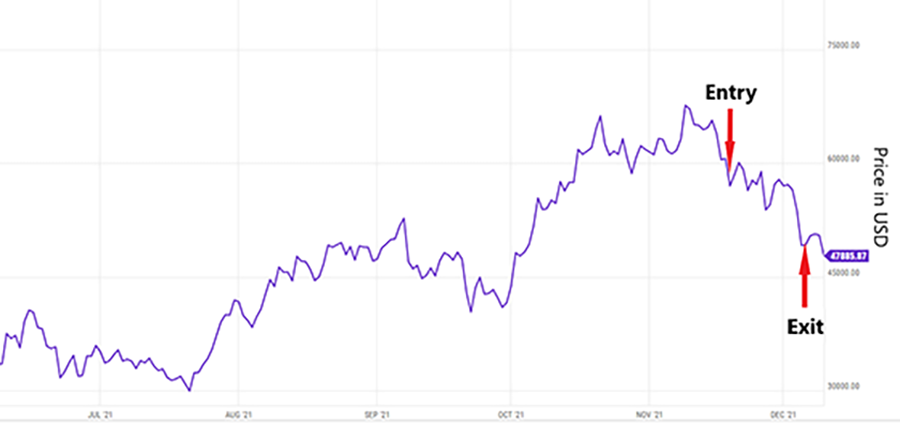|
Larry’s note: Welcome to Trading with Larry Benedict, the brand new free daily eletter, designed and written to help you make sense of today’s markets. I’m glad you can join us. My name is Larry Benedict. I’ve been trading the markets for over 30 years. I got my start in 1984, working in the Chicago Board Options Exchange. From there, I moved on to manage my own $800 million hedge fund, where I had 20 profitable years in a row. And, I’ve been featured in the book Market Wizards, alongside investors like Paul Tudor Jones. But these days, rather than just trading for billionaires, I spend a large part of my time helping regular investors make money from the markets. My goal with these essays is to give you insight on the most interesting areas of the market for traders right now. Let’s get right into it… |
For several years now, it seems as though the financial world has been consumed by just one thing… cryptocurrency.
Tokens jumping or crashing by double (and sometimes triple) digit percentages has become a regular daily phenomenon.
And, as we’ve seen many times this year, a single tweet from a famous billionaire can have a token go through the roof (or floor)… Sometimes in the space of just 24 hours!
Even the biggest crypto of them all, bitcoin, isn’t immune to eye-watering corrections…
While many investors believe they should have some crypto exposure, wading through thousands (one estimate puts it at over 13,500) of tradable coins is just simply impossible.
Not to mention the stress of dealing with huge potential losses and the need to safely store their holdings in a digital wallet. It’s enough for many to believe that crypto is too difficult.
However, over the coming days, I’m going to share with you one way I trade the crypto sector. In fact, it’s a strategy we’ve used very recently with my trading service, The Opportunistic Trader.
Today, we’ll kick off with a trade we did with bitcoin… without having to buy or store it directly. Then, we’ll analyze a series of trades we did on a part of the crypto space that some investors overlook – crypto mining.
The product we used to trade bitcoin is the ProShares Bitcoin Strategy ETF (BITO) – an ETF launched on October 19 with around $1.3 billion assets under management and turning over around $300 million a day.
BITO doesn’t buy or sell bitcoin directly… instead it seeks to replicate the bitcoin price by holding CME-listed bitcoin futures contracts. This means that it’s managed and controlled by a regulated exchange.
With BITO breaking down below its 10-day moving average (MA – red line), we entered a short position on November 18.
Take a look below…
ProShares Bitcoin Strategy ETF (BITO)

Source: eSignal
As a reminder, I use bar charts because they show where the price opened (hash on left side) and closed (hash on right side), as well as the high and low for the period.
Because of BITO’s short price history, let’s check out a chart of the bitcoin price over the past six months to give us some more context…
Bitcoin Price

Source: Y-Charts
We bought a put option on BITO to gain short exposure. When a share price falls, a put option should increase in value.
And that’s exactly what we saw with our trade in The Opportunistic Trader. After entering our trade on November 18 by buying a put option, we sold it to close the position on December 6 for a 72.3% profit.
To be clear, using options can magnify the returns (and losses) you can generate compared to trading ordinary shares. However, there’s another reason why using options can be particularly helpful when it comes to trading bitcoin…
And that comes back to what we touched on earlier about dealing with the huge swings that bitcoin and other cryptos go through.
By buying an option, we know before we place a trade exactly what our maximum loss might be. And that means we have full control in managing our risk, especially when you compare it to holding the tokens outright.
So, if we think bitcoin is going to rise, we can buy a call option on BITO. If our analysis proves wrong and the BITO share price instead tanks, the most we can lose is the premium we paid to buy the option.
Similarly, had our analysis in our BITO trade proved wrong – and the BITO share price rose instead – the most we would’ve lost is the premium we paid.
You can see how using this bought-option strategy – having a known and quantifiable risk – could be a real game changer in how you trade bitcoin.
Tune in tomorrow where I’ll show you just how much this strategy saved us when we took out a put option on crypto miner, Marathon Digital Holdings (MARA)…
Regards,
Larry Benedict
Editor, Trading With Larry Benedict
Reader Mailbag
Do you trade bitcoin? If so, do you prefer trading the coins directly or through proxies like BITO?
P.S. We’re excited to hear what you think of your new eletter, Trading With Larry Benedict. Let us know at [email protected].